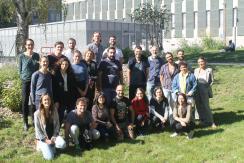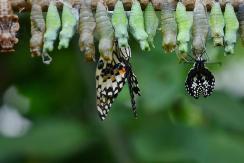COEVOL Multi-Scale Coevolution
Living systems are highly integrated, with a multitude of levels of organization, from molecular and intra-cellular scales to ecosystems. Complex organisms are themselves consortia of macro- and micro-organisms, which work together with their host to build the individual. Yet, each of these organisms can function and evolve in the short term according to its own logic, possibly in conflict with other higher or lower levels, or with other time scales. The once common idea among evolutionists that natural selection results in organisms perfectly adapted to their environment is now severely undermined. Not only because, as the Red Queen explains to Alice, one has to run relentlessly to keep its place in a changing environment, or because past evolutionary history and chance constrain the possibilities of present adaptation, but also because different levels of selection have interests that are generally difficult to reconcile.
Multi-scale coevolution resets classical questions in evolutionary biology
One example, of particular interest is the question of the source of heritable variations. The phenotype of organisms in a population is influenced not only by variations in their nuclear and mitochondrial genomes, the dynamics of which is the object of population genetics, but also more and more patently by the consortium of microbes and genetic elements that constitute its microbiome and virome. The hologenome designates this complex assembly of genetic materials, which obey different rules of transmission and different evolutionary strategies. The ability of symbionts to manipulate host phenotypes or to interfere with each other influences the evolutionary dynamics of all players in ways that are yet poorly understood. In addition, new questions arise, such as the importance of co-adaptation in these systems and their consequences in maintaining cohesive biological systems.
- Symbiosis: a response to and a source of divergent selection
Using a variety of approaches combining experimental evolution, genomic, functional, phenotypic and behavioral data, we aim to test whether symbiosis facilitates diversification and to characterize the underlying microevolutionary processes.
- Ecological networks of horizontal gene transfer
We develop original methods to detect gene transfer and we investigate the factors that influence the routes of gene transfers among microbes but also among insects.
- The interplay between symbiosis, infection and immunity and its evolutionary consequences
We try to understand the intimate interaction of hosts with pathogens, symbionts and transposable elements and how it affects the extended phenotype of the host.
- Transgenerational inheritance and environment changes
We try to decipher the molecular mechanisms that underlie rapid adaptation to environment and to test for transgenerational inheritance of fitness traits.
- Intragenomic conflicts and demography
We are developing models to test whether changes in the demography of the host affect the dynamics of transposable elements.
- The determinism of phenotypic convergence
We study the genomic basis of convergent phenotypic evolution in particular in the case of animals and plants adaptation to increasing temperature and decreasing water.
- Reconciling the tree of life
We develop phylogenetic methods for “reconciling” gene/species or host/symbiont histories and use these methods to explore the bulk of extinct or undescribed species and the history of association of symbiotic microbes with their hosts.
Integrating methods
The methods we use to tackle the questions raised by multi-scale co-evolution extend from theory, modelling and simulation to big data analysis, lab (notably on insects), and to a lesser extent, field activities.
Implication of research, responsibility of researchers and citizen sciences
From our research (some of which have immediate consequences in health, agriculture and ecology) and our concerns about the responsibility of scientists in society, we are committed to promote an “implicative” research. The implicative position means that we try to work on the link between science and society, not only through a one-way communication, applying or explaining our science, but also favoring early discussions on research projects, that may influence our research directions.
Publications
Display of 91 to 120 publications on 706 in total
The assembly of the rice weevil Sitophilus oryzae is dominated by transposable elements and shades light on the evolution of endosymbiosis in a major crop pest.
Arthropod Genomics Symposium 2022 .
Conference paper
see the publicationEfficient compartmentalization in insect bacteriomes protects symbiotic bacteria from host immune system
10th congress of the International Symbiosis Society (ISS) - 3rd International Conference on Holobionts (joint meeting) .
Poster
see the publicationTransposable element regulation in the cereal weevil Sitophilus oryzae and its potential association with an endosymbiotic bacteria
CNET (23d congrès national des éléments transposables) .
Conference paper
see the publicationSterile Insect Technique: Principles, Deployment and Prospects
Extended Biocontrol . : 55-67
Book chapter
see the publicationDes embouchures métalliques de trompettes romaines dans les puits de Troussepoil-Le Bernard (Vendée)
Aquitania . 38 : 353-372
Journal article
see the publicationEfficient compartmentalization in insect bacteriomes protects symbiotic bacteria from host immune system
Microbiome . 10 ( 1 ) : 156
Journal article
see the publicationThe crisis of the scientific mind : an investigation, a tragedy and a collective redistribution of roles
Les Cahiers de Framespa : e-Storia . ( 40 )
Journal article
see the publicationCalculs d’inférence dans les arbres phylogénétiques
Modèles et méthodes pour l’évolution biologique . 9781789480696 : 177-202
Book chapter
see the publicationGenomic characterization of viruses associated with the parasitoid Anagyrus vladimiri (Hymenoptera: Encyrtidae)
Journal of General Virology . 103 ( 12 )
DOI: 10.1099/jgv.0.001810
Journal article
see the publicationInfluence of bacterial symbionts on host niche and ecological diversification: an integrative approach in a whitefly model
XXVI International Congress of Entomology .
Poster
see the publicationInfluence of secondary symbionts on host plant utilization and selection in the whitefly Bemisia tabaci.
10th congress of the International Symbiosis Society (ISS) - 3rd International Conference on Holobionts (joint meeting) .
Poster
see the publicationRole of symbionts in insects' ecological diversification: cytotype influences exploitation of an unfavorable host plant in the sap-feeder Bemisia tabaci (Hemiptera: Aleyrodidae).
Rencontres du Groupe Régional de Recherche en Microbiologie des Interactions (G-RREMI) 2022 .
Poster
see the publicationAnalyses of symbiotic bacterial communities in the plant pest Bemisia tabaci reveal high prevalence of Candidatus Hemipteriphilus asiaticus on the African continent
Peer Community Journal . 2 ( e20 )
Journal article
see the publicationDiversity and evolution of pigment types in marine $Synechococcus$ cyanobacteria
Genome Biology and Evolution . 14 ( 4 ) : evac035
DOI: 10.1093/gbe/evac035
Journal article
see the publicationAdaptation to host cell environment during experimental evolution of Zika virus
Communications Biology . 5 ( 1 ) : 1115
Journal article
see the publicationEvaluation of methods to detect shifts in directional selection at the genome scale
Preprint
see the publicationNucleotide Usage Biases Distort Inferences of the Species Tree
DOI: 10.1093/gbe/evab290
Preprint
see the publicationPolymorphism‐aware estimation of species trees and evolutionary forces from genomic sequences with RevBayes
Methods in Ecology and Evolution . 13 ( 11 ) : 2339-2346
Journal article
see the publicationRelative Time Constraints Improve Molecular Dating
Systematic Biology . 71 ( 4 ) : 797-809
Journal article
see the publicationVers une représentation sonore des arbres phylogénétiques
16ème Congrès Français d'Acoustique, CFA2022 .
Conference paper
see the publicationtidy tree : A New Layout for Phylogenetic Trees
Molecular Biology and Evolution . 39 ( 10 ) : msac204
Journal article
see the publicationLarval density in the invasive Drosophila suzukii : immediate and delayed effects on life-history traits
Preprint
see the publicationHigh-throughput genomics and transcriptomics to decipher host-symbiont molecular dialogue in the cereal weevil Sitophilus oryzae and Sodalis pierantonius endosymbiotic association
10th congress of the International Symbiosis Society (ISS) - 3rd International Conference on Holobionts (joint meeting) .
Poster
see the publicationGhost lineages can invalidate or even reverse findings regarding gene flow
PLoS Biology . 20 ( 9 ) : e3001776
Journal article
see the publicationGOntact: using chromatin contacts to infer Gene Ontology enrichments for cis -regulatory elements
Preprint
see the publicationDistinct evolutionary trajectories of SARS-CoV-2-interacting proteins in bats and primates identify important host determinants of COVID-19
Proceedings of the National Academy of Sciences of the United States of America . 119 ( 35 )
Journal article
see the publicationExtreme mitochondrial DNA divergence underlies genetic conflict over sex determination
Current Biology . 32 ( 10 ) : 2325-2333.e1-e6
Journal article
see the publicationPhyloformer: towards fast and accurate phylogeny estimation with self-attention networks
Preprint
see the publicationBayesian investigation of SARS-CoV-2-related mortality in France
Peer Community Journal . 2 ( e6 )
Journal article
see the publicationA hapless mathematical contribution to biology
History and Philosophy of the Life Sciences . 44 ( 34 )
Journal article
see the publication

